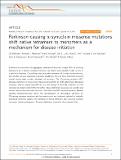| dc.contributor.author | Dettmer, Ulf | |
| dc.contributor.author | Newman, Andrew J. | |
| dc.contributor.author | Soldner, Frank | |
| dc.contributor.author | Luth, Eric S. | |
| dc.contributor.author | Kim, Nora C. | |
| dc.contributor.author | von Saucken, Victoria E. | |
| dc.contributor.author | Sanderson, John B. | |
| dc.contributor.author | Jaenisch, Rudolf | |
| dc.contributor.author | Bartels, Tim | |
| dc.contributor.author | Selkoe, Dennis | |
| dc.date.accessioned | 2015-09-14T13:41:43Z | |
| dc.date.available | 2015-09-14T13:41:43Z | |
| dc.date.issued | 2015-06 | |
| dc.date.submitted | 2015-02 | |
| dc.identifier.issn | 2041-1723 | |
| dc.identifier.uri | http://hdl.handle.net/1721.1/98476 | |
| dc.description.abstract | β-Sheet-rich α-synuclein (αS) aggregates characterize Parkinson’s disease (PD). αS was long believed to be a natively unfolded monomer, but recent work suggests it also occurs in α-helix-rich tetramers. Crosslinking traps principally tetrameric αS in intact normal neurons, but not after cell lysis, suggesting a dynamic equilibrium. Here we show that freshly biopsied normal human brain contains abundant αS tetramers. The PD-causing mutation A53T decreases tetramers in mouse brain. Neurons derived from an A53T patient have decreased tetramers. Neurons expressing E46K do also, and adding 1-2 E46K-like mutations into the canonical αS repeat motifs (KTKEGV) further reduces tetramers, decreases αS solubility and induces neurotoxicity and round inclusions. The other three fPD missense mutations likewise decrease tetramer:monomer ratios. The destabilization of physiological tetramers by PD-causing missense mutations and the neurotoxicity and inclusions induced by markedly decreasing tetramers suggest that decreased α-helical tetramers and increased unfolded monomers initiate pathogenesis. Tetramer-stabilizing compounds should prevent this. | en_US |
| dc.description.sponsorship | National Institutes of Health (U.S.) (Grant 5R37 CA84198) | en_US |
| dc.description.sponsorship | National Institutes of Health (U.S.) (Grant HD045022) | en_US |
| dc.language.iso | en_US | |
| dc.publisher | Nature Publishing Group | en_US |
| dc.relation.isversionof | http://dx.doi.org/10.1038/ncomms8314 | en_US |
| dc.rights | Creative Commons Attribution | en_US |
| dc.rights.uri | http://creativecommons.org/licenses/by/4.0/ | en_US |
| dc.source | Nature Publishing Group | en_US |
| dc.title | Parkinson-causing α-synuclein missense mutations shift native tetramers to monomers as a mechanism for disease initiation | en_US |
| dc.type | Article | en_US |
| dc.identifier.citation | Dettmer, Ulf, Andrew J. Newman, Frank Soldner, Eric S. Luth, Nora C. Kim, Victoria E. von Saucken, John B. Sanderson, Rudolf Jaenisch, Tim Bartels, and Dennis Selkoe. “Parkinson-Causing α-Synuclein Missense Mutations Shift Native Tetramers to Monomers as a Mechanism for Disease Initiation.” Nature Communications 6 (June 16, 2015): 7314. © 2015 Macmillan Publishers Limited | en_US |
| dc.contributor.department | Massachusetts Institute of Technology. Department of Biology | en_US |
| dc.contributor.department | Whitehead Institute for Biomedical Research | en_US |
| dc.contributor.mitauthor | Jaenisch, Rudolf | en_US |
| dc.relation.journal | Nature Communications | en_US |
| dc.eprint.version | Final published version | en_US |
| dc.type.uri | http://purl.org/eprint/type/JournalArticle | en_US |
| eprint.status | http://purl.org/eprint/status/PeerReviewed | en_US |
| dspace.orderedauthors | Dettmer, Ulf; Newman, Andrew J.; Soldner, Frank; Luth, Eric S.; Kim, Nora C.; von Saucken, Victoria E.; Sanderson, John B.; Jaenisch, Rudolf; Bartels, Tim; Selkoe, Dennis | en_US |
| mit.license | PUBLISHER_CC | en_US |
| mit.metadata.status | Complete | |
